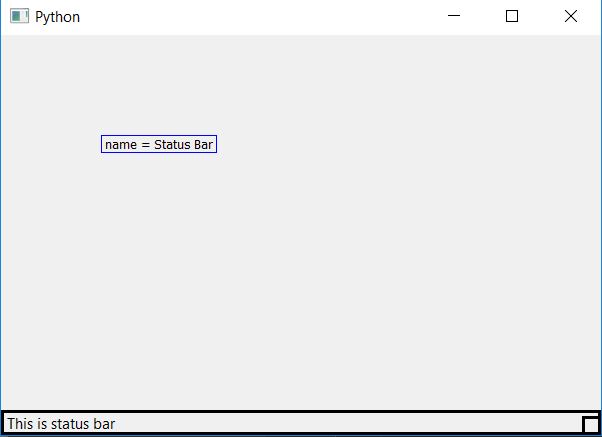PyQt5 – 设置和访问状态栏的名称
在设计一个Gui(图形用户界面)应用程序时,我们通常会制作很多窗口,每个窗口都有状态栏。对于后端代码员来说,区分窗口的状态栏变得很困难。为了克服这个需要设置名称的问题,在数百个状态栏中,我们可以通过设置它们的名称来区分它们,比如有些是 “状态-信息 “状态栏,有些是 “状态警告 “状态栏,就像这样。
为了设置状态栏的名称,我们使用 statusBar().setAccessibleName() 方法,为了访问这个名称,我们使用 statusBar().accessibleName() 方法。
语法:
self.statusBar().setAccessibleName(name)
statusBar().accessibleName()
参数:
statusBar().setAccessibleName()使用字符串作为参数。
statusBar().accessibleName()不使用参数。
返回 :
statusBar().setAccessibleName()返回 None。
statusBar().setAccessibleName()返回 string。
代码 :
from PyQt5.QtCore import *
from PyQt5.QtGui import *
from PyQt5.QtWidgets import *
import sys
class Window(QMainWindow):
def __init__(self):
super().__init__()
# set the title
self.setWindowTitle("Python")
# setting the geometry of window
self.setGeometry(60, 60, 600, 400)
# setting status bar message
self.statusBar().showMessage("This is status bar")
# setting border
self.statusBar().setStyleSheet("border :3px solid black;")
# setting name to a status bar
self.statusBar().setAccessibleName("Status Bar")
# creating a label widget
self.label_1 = QLabel(self)
# moving position
self.label_1.move(100, 100)
# setting up the border
self.label_1.setStyleSheet("border :1px solid blue;")
# getting name of status bar
name = self.statusBar().accessibleName()
# setting text to label
self.label_1.setText("name = "+name)
# resizing label
self.label_1.adjustSize()
# show all the widgets
self.show()
# create pyqt5 app
App = QApplication(sys.argv)
# create the instance of our Window
window = Window()
# start the app
sys.exit(App.exec())
输出 :

 极客教程
极客教程